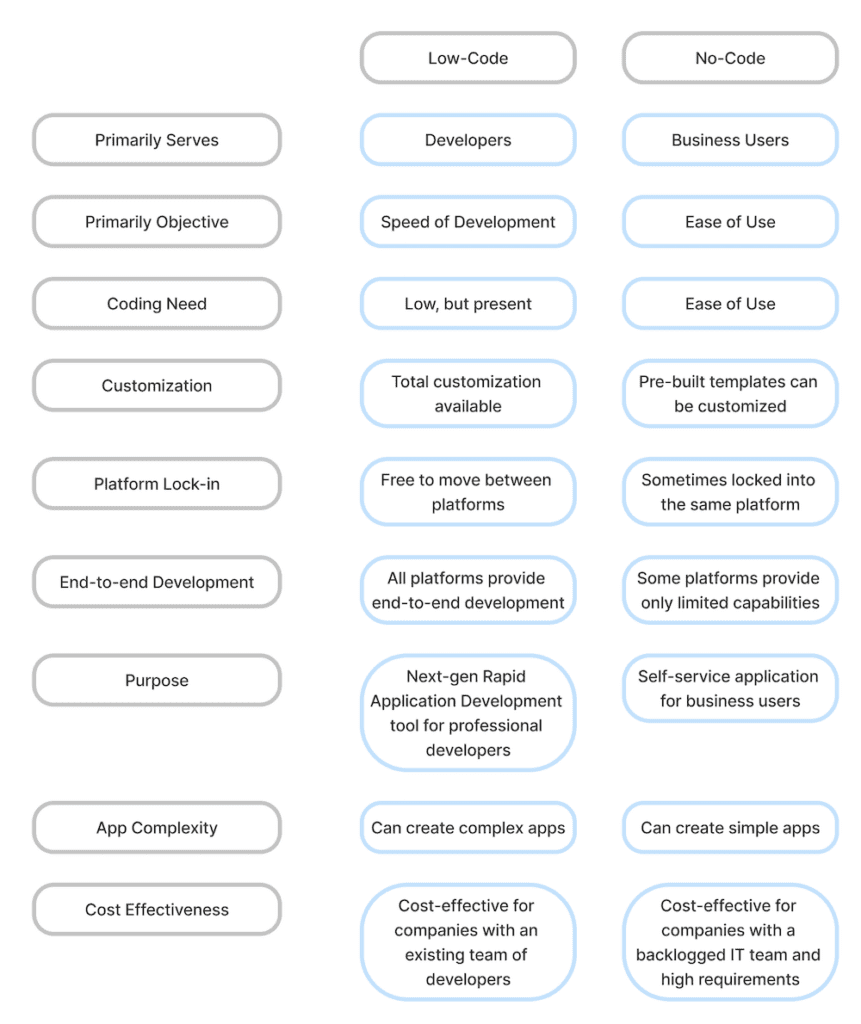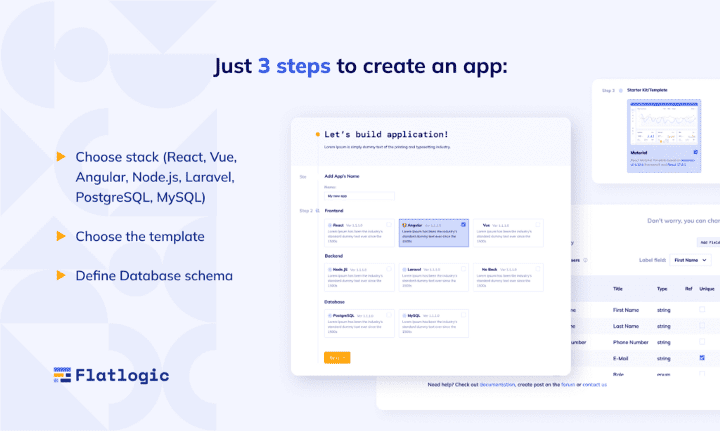When developing apps and processes, low-code software development techniques utilize little to no coding. You may substitute visual interfaces with straightforward logic and drag-and-drop capabilities for complex programming languages in a minimum code development environment. Even anyone without substantial coding or program production abilities may create software for several purposes, such as creating mobile and business apps, using these straightforward techniques.
No coding is a visual development environment that allows non-technical users to build apps by dragging and dropping software components to create a whole app. Users who have no prior coding experience can construct apps without writing any code.
What are Low-Code and No-Code Platforms?
Low code and no code development platforms may be used to design, build, launch, and modify enterprise-grade programs. These platforms were made to enable professional developers and corporate users with little to no coding skills to do so.
The two systems with no coding are the easiest to use. A visual, drag-and-drop, no-code architecture may be used to create simple, useful programs. The integration possibilities are restricted, and, likely, you won’t be able to successfully accelerate or modify legacy systems here. Instead, this kind of development works best when helping teams with narrowly focused, specialized requirements.
The simplicity and ease of no-code platforms can have certain disadvantages. Because so much of its architecture is predetermined by those who built it, the ability to change it is minimal to nonexistent.
Given that they offer few features, why have no-code systems been able to last this long? This is especially true if you do not want to (or simply cannot) wait for your internal IT personnel to construct anything for you because they are easy to use even if you have no coding expertise or competence.
As a sort of middle ground between total human coding and no-code, low-code solutions are more flexible. Like their no-code equivalents, low-code systems can include drag-and-drop functionality and be graphical. They also give designers the best of both worlds in that development speed may be accelerated without having to repeatedly copy basic code since they are open, flexible, and permit coding or programming. Scalable designs, open APIs for renewability, and flexible implementation options in the cloud or on-premises are benefits of low-code platforms.
Difference between Low Code & No Code

Low-code platforms are often used by IT professionals with coding experience to create complex custom applications, whereas no-code platforms allow business users to build apps without any coding to achieve their business goals. By examining the qualities given below, you may learn more about the variations between low-code and no-code development platforms:
- Depending on the type of program, application integration may entail merging data from several platforms. Low-code development platforms generally offer great system integration flexibility, whereas no-code systems frequently fall short. Because shadow IT might develop through the creation of apps without sufficient oversight or inspection. Security threats, regulatory challenges, integration issues, resource-intensive applications, and rising technological debt are just a few of the potential outcomes.
- Anyone with a basic understanding of technology may use platforms for no-code programming. Low-code platforms provide customization and come with more sophisticated tools, but they are only appropriate for those who are skilled in programming. As a result, staff members might benefit from low code training.
- Low code and no code development platforms may both be used to create corporate apps for internal usage. Conversely, low-code platforms enable the creation of well-known programs that support important business procedures. No code development environments are ideal for building software that can handle basic business problems by itself.
- The debate that has come before has shown that no-code platforms are perfect for any employee who wants to innovate and enhance processes. Platforms with low code are built for creating enterprise-level apps. As a consequence, it’s a great tool for DevOps teams and software engineers aiming to save costs and time associated with development.

No Code may assist an organization’s operations and return on investment in a variety of ways. However, you may be asking how no-code solutions may be customized to benefit your organization specifically. The following are some of the use cases that no-code has to offer, regardless of size or industry:
- For business intelligence analysts and programmers who wish to transform raw data into useful insights, the best reporting tools are crucial. No code solutions will prove to be just what you want. Real-time access to your company’s data is possible, and you can use no-code to transform it into useful data grids, visualizations, and significant statistics.
- Software for managing data. Using a no-code platform, you may connect your data sources to any database, such as MS SQL Server, MySQL, PostgreSQL, and others. The data may then be updated, edited, added, deleted, etc. Business database apps may be created fast and easily. Collaborative information collection, storing, sharing, and sharing have become easier. A data export/import feature, configurable interface, modular expandable structure, and ready-to-use templates are all included with your code-free bespoke database.
Low Code platforms may be used to build more complex programs and can handle a larger range of use cases due to their general-purpose nature.
- new technology application cases that are creative. Various low-code solutions can make use of access tools, face and voice recognition services, cryptocurrencies, machine learning, artificial intelligence, and other cloud-based digital services provided by third parties. Additionally, they have access to substantial component libraries created by professionals in the field.
- Pre-built user interface designs for mobile customer experience applications are there to assist you to improve usability and acceptability while keeping the integrity of your brand’s marketing plan.
- cross-department and cross-domain applications that increase productivity and efficiency.
When using low- & no code
Both low-code and no-code offer benefits. The parallels between the two do not make this decision any simpler. The best course of action is to assess the current needs and make the proper decision. Take into account the following questions to determine consumer demands:
- What goals are pursued while using low- or no-code software?
- Who utilizes the services? How proficient are they in programming?
- What is the scope and size of the problem that has to be fixed?
- Does the construction need the integration of specialist internal and external applications?
- How long should it take to turn things around?
- How much say do customers want to have on the code?
- Is sensitive data handling or security consideration required for the application?
What is the program used for and who will construct it are the two most important queries in this situation. Although all of these are significant issues, it is preferable to take a goal-centric rather than a user-centric approach, meaning that the what is more crucial than the who.
Low-code is the preferable solution if the use cases are complicated, call for connections with other on-premises or cloud apps, have customer-facing or business-critical needs, or need to be distributed throughout the company. In this situation, collaborations with IT teams or training programs can address the issues even if users lack the necessary competence in programming languages.
Why use Flatlogic Platform for Low Code/No Code development
The development industry has an obvious use for low-code and no-code platforms. Gartner predicts that they will take over the market within a few years, therefore ignoring the benefits that these tactics provide might cost an organization opportunities.
To accommodate a variety of developers inside an organization, search for a low-code development platform that offers specialized tools, integrated collaboration, and a cloud-native architecture.
The requirement for coding expertise is diminished by low-code platforms, which use a visual, model-driven approach. They also change how lines of business collaborate with IT development teams to create applications.

Flatlogic Platform – is a platform that helps you to create, host, and develop a fully workable CRUD web application with front-end, back-end, and database. The generated application is an excellent foundation for further development with user authentication, data management, and a ready-made basic structure.
Flatlogic full-stack web application generator is a tool for the fast creation of web applications from scratch. The agency provides the UI for creating the database schema from which you generate the application code base. All you have to do is think about your future application’s database schema. Equally importantly, you can also create static websites using our generator.
You can create almost any type of web application with the help of the tool:
- CRM;
- Headless CMS;
- E-commerce CMS;
- Admin Panel;
- Data management app;
- Inventory management application;
- UI for the database.
Let’s take a look at the features of applications generated using the Flatlogic full-stack web application generator:
- The application created with Flatlogic is fully responsive;
- The application has ready-to-use authorization and authentication features;
- According to the previously created database structure, all backend and frontend logic is created automatically;
- Each application comes with a Docker container that facilitates deployment on any hosting platform;
- Flatlogic automatically creates a Swagger-documented API for each element generated by the generator;
- Forms, buttons, tables, and the entire layout are pre-configured;
- The tool is also fully integrated with GitHub, so you can quickly create new entities and tables without writing new code, publish them to GitHub and collaborate with other developers on your project;
- The WYSIWYG editor is ready to use in the apps you create;
- The application will include some search, filtering, and validation features.

Comments